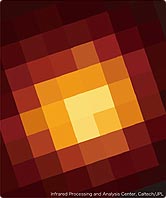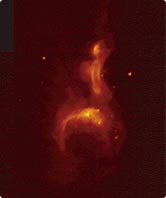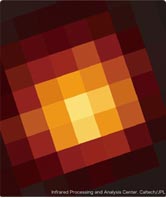Infrared observations essential to astronomy—better sensitivity and resolution
What is the AKARI (ASTRO-F) satellite?

AKARI before launch was known as ASTRO-F.
AKARI is a satellite dedicated for infrared observations. It is equipped with a Ritchey-Chr?tien reflecting telescope with an effective aperture of 68.5 cm (the diameter of the primary mirror is 71 cm) and a focal length of 420 cm. The AKARI focal plane encompasses two main instruments, the two-channel, four-band Far-Infrared Surveyor (FIS)*1 and the InfraRed Camera (IRC)*2 comprising of one near- and two mid-infrared channels. The number of pixels for the infrared sensing devices range from 75 pixels (for the FIS) to 200,000 pixels (for the IRC). These numbers are very low compared to the latest digital cameras. However, they represent a quantum leap forward compared to the IRAS satellite, which consisted merely of rows of a few tens of individual sensor elements.
The telescope and observation equipment are completely enclosed within a cryogenic container (cryostat) similar to a vacuum flask (known as a cryostat), connected to a cooling system. This “mission module” is mounted on a “bus module”, which controls the satellite's attitude and handles communication to and from the Earth. Cylindrical in shape, the satellite stands approximately 3.7 m high, is 1.9 m in diameter, and has a total weight when launched of 952 kg—making AKARI roughly the same size and weight as a compact car.
- *1Far-Infrared Surveyor (FIS)
The instrument for far-Infrared observations onboard AKARI. The detector is made of Gallium doped Germanium crystals. Observations are carried out in four wavelength bands using two types of infrared detector: a 100-pixel detector for wavelengths of 50–110 μm and a 75-pixel detector for wavelengths of 110–180 μm. The FIS has been developed by Nagoya University, JAXA, National Astronomical Observatory and other collaborative institutes. The far-infrared detectors were developed in collaboration with the National Institute of Information and Communications Technology. - *2InfraRed Camera (IRC)
An instrument for wide-field imaging observations at near- and mid-infrared wavelengths that consists of three separate cameras. Large format infrared array detectors are used. The observer can select the observing wavelength by switching the filters of the cameras. The IRC has been developed by the University of Tokyo, JAXA and other collaborative institutes.

Left: Inside the cryostat Right: The infrared telescope
How have sensitivities and resolutions improved since the IRAS era?
As a space telescope, the improvement is not so apparent—the IRAS satellite had a 60 cm telescope, whereas AKARI has an aperture of 68.5 cm. This is due to constraints of the cargo size and weight limitations of the launch rocket. The telescope system is also quite similar to ground-based telescopes. Since the principal objective of AKARI is to conduct an all-sky survey, the intention behind the optical design is to allow high-quality imagery over a wide field of view (or viewing angle). By improving the optical accuracy of the primary and secondary mirrors, the resolution of the AKARI observations is about one order of magnitude better than that of the IRAS observations. Similar development in infrared detector technology has also produced improved sensitivities.
As a result, fainter, more distant astronomical objects become visible, and their composition can be seen in much finer detail. Astronomy using infrared radiation has various aims. Some researchers wish to see how entire galaxies are formed on global scales, while other researchers endeavor to seek out individual stars being born within a galaxy. More precise size measurements and other data on asteroids within our Solar System are being obtained by observing them in infrared rays. Whereas X-rays are used to observe certain specific astronomical objects under extremely high temperatures, and observations at optical wavelengths are most often used for objects such as fixed stars and bright galaxies, infrared light is used to observe the low-temperature gas of outer space itself, which constitutes the greater part of the volume of our Universe. It is thus a significant step in astronomy that such widely used fundamental data are being revisited with 10 times higher resolution and better sensitivity.
Far-infrared images of the IC4954 reflection nebula (wavelength 90 μm)

AKARI/Far-Infrared Surveyor (FIS)

IRAS image (100 μm)
Mid infrared images of the IC4954 reflection nebula (wavelength 9 μm)

AKARI/InfraRed Camera (IRC)

IRAS image (12 μm)
- The precision of AKARI is an order of magnitude greater than that of the IRAS images.
Images (left) captured with the AKARI far infrared surveyor (FIS), and AKARI Near- and Mid Infrared Camera (IRC), and IRAS images (right).

